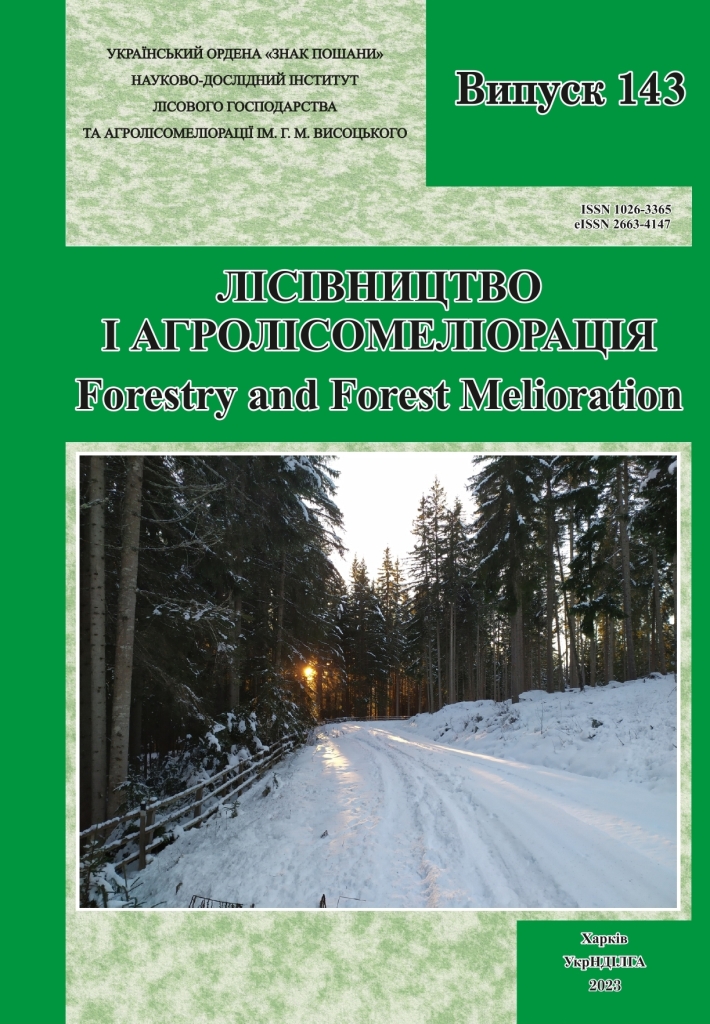Анотація
У насадженнях Pinus sylvestris L. Харківської області досліджували видовий склад, чисельність і сезонну динаміку короїдів та їхніх хижаків у дослідах із різним поєднанням феромонних пасток і диспенсерів. Тестували три типи пасток і феромони Ips acuminatus та I. sexdentatus (виробник – іспанська компанія Sanidad agricola econex s.l.). У пастках трьох типів (A – тунельні; B – Тайсона; C – Кростреп®міні) з феромонами Ips acuminatus and I. sexdentatus виловлено п’ять видів короїдів (Curculionidae: Scolytinae), п’ять видів вусачів (Cerambycidae), п’ять видів хижих комах із родин Histeridae, Cleridae, Nitidulidae, Monotomidae та Tenebrionidae, а також представників родин Staphylinidae, Carabidae та Elateridae. Цільові види – I. acuminatus та I. sexdentatus становили 51 і 31 % усіх виловлених жуків відповідно. Їхні чисельність, сезонна динаміка та участь у видовому складі залежали від типів пастки, феромону та диспансерів. Найбільшу кількість жуків I. acuminatus виловлено у пастки Crosstrap® mini traps (тип C), а I. sexdentatus – у пастки Theyson (тип B). За збільшення кількості диспенсерів виловлено більшу кількість I. acuminatus, але це не мало значущого впливу на виловлену кількість I. sexdentatus.Чисельність виловлених жуків Th. formicarius була найменшою у пастках типу B (Theyson), а найбільшою – у пастках типу С (Crosstrap® mini). Чисельність виловлених жуків Th. formicarius у пастках A і C з феромоном I. acuminatus була більшою, ніж у пастках із феромоном I. sexdentatus. Різниці цього показника за більшої кількості диспенсерів із феромоном I. acuminatus є значущими, а з феромоном I. sexdentatus – незначущими.
Посилання
Andreieva, O. Yu., Vyshnevskyi, A. V., Boliujh, S. V. 2019. Population dynamics of bark beetles in the pine forests of Zhytomyr region. Scientific Bulletin of UNFU, 29(8): 31–35(in Ukrainian). https://doi.org/10.36930/40290803
Atramentova, L. A. and Utevskaya, O. M. 2008. Statistical methods in biology. Gorlovka, Likhtar, 248 p. (in Russian).
Colombari, F., Schroeder, M. L., Battisti, A., Faccoli, M. 2013. Spatio-temporal dynamics of an Ips acuminatus outbreak and implications for management. Agricultural and Forest Entomology, 15: 34–42. https://doi.org/10.1111/j.1461-9563.2012.00589.x
Erdo?an, C. 2024. Investigation of possible use of pheromone trap for adult population development and control of Ips sexdentatus (B?rner, 1776) (Coleoptera: Scolytidae) damaging black pine in Ba?kent University Ba?l?ca Campus afforestation area. Turkish Journal of Entomology, 48(1): 3–14. https://doi.org/10.16970/entoted.1352020
Faccoli, M., Gallego, D., Branco, M., Brockerhoff, E. G., Corley, J., Coyle, D. R., ... , Avtzis, D. 2020. A first worldwide multispecies survey of invasive Mediterranean pine bark beetles (Coleoptera: Curculionidae, Scolytinae). Biological Invasions, 22: 1785–1799. https://doi.org/10.1007/s10530-020-02219-3
Kn??ek, M., Li?ka, J., V?le, A. 2022. Efficacy of synthetic lures for pine bark beetle monitoring. Journal of Forest Science, 68(1): 19–25. https://doi.org/10.17221/139/2021-JFS
Lantschner, M. V. and Corley, J. C. 2023. Spatiotemporal outbreak dynamics of bark and wood-boring insects. Current Opinion in Insect Science, 55: 101003. https://doi.org/10.1016/j.cois.2022.101003
Li?ka J., Kn??ek M., V?le A. 2021. Evaluation of insect pest occurrence in areas of calamitous mortality of Scots pine. Central European Forestry Journal, 67: 85–90. https://doi.org/10.2478/forj-2021-0006
Meshkova, V. 2021. The lessons of Scots pine forest decline in Ukraine. Environ. Sci. Proc., 3 (1): 28. https://doi.org/10.3390/IECF2020-07990/
Meshkova, V. L., Vorobei, A. D., Omelich, A. R. 2022. Coleopterous predators of bark beetles in the last years of the outbreak. Folia Forestalia Polonica, Series A – Forestry, 64 (3): 161–172. https://doi.org/10.2478/ffp-2022-0016
Miller, D. R. and Asaro, C. 2023. Predators attracted to combination of bark beetle pheromones and host kairomones in pine forests of southeastern United States. Environmental Entomology, 52(5): 787–794. https://doi.org/10.1093/ee/nvad076
Vorobei, A. D. 2022. Species composition dynamics for bark beetles and their predators from Coleoptera family in pine stands of the Zhovtneve State Forest Enterprise (Kharkiv region) in 2019–2022. Forestry and Forest Melioration, 141: 110–116 (in Ukrainian). https://doi.org/10.33220/1026-3365.141.2022.110
Warzee, N., Gilbert, M., Gregoire, J. C. 2006. Predator/prey ratios: a measure of bark-beetle population status influenced by stand composition in different French stands after the 1999 storms. Annals of Forest Science, 63(3): 301–308. https://doi.org/10.1051/forest:2006009
Wermelinger, B., Rigling, A., Schneider Mathis, D., Kenis, M., Gossner,M. M. 2021. Climate change effects on trophic interactions of bark beetles in inner alpine Scots pine forests. Forests, 12(2): 136–151. https://doi.org/10.3390/f12020136

Ця робота ліцензується відповідно до Creative Commons Attribution 4.0 International License.
